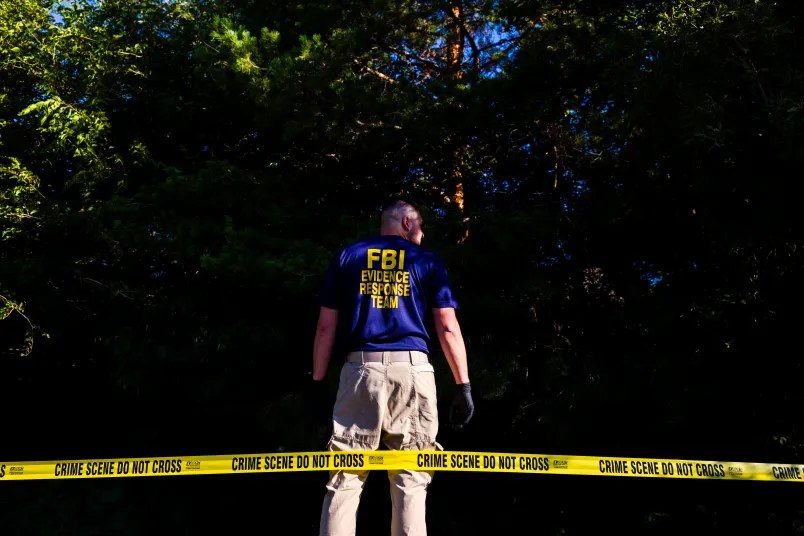In July, Franklin School District Superintendent Dan LeGallo got a surprise letter from the Department of Homeland Security.
Since late last year, LeGallo had used a $486,386 DHS grant to fund three positions focused on mental health, truancy, and other student issues in his rural New Hampshire district. The grant money came from a program started in Trump’s first term aimed at preventing targeted acts of violence, including political violence. For Franklin School District, that funding came to a halt with a terse July missive: the grant was no longer aligned with DHS’ “essential mission of enforcing immigration laws, securing the border, and combating anti-Semitism,” the Department wrote in a message obtained by TPM.
Previous grants, the letter continued, “resulted in the funding of openly partisan and political organizations as well as the funding of projects within sanctuary jurisdictions that blatantly disregarded federal immigration law.”

“It was a pretty damning letter,” LeGallo said.
Franklin schools’ funds are one example of more than $15 million in targeted violence prevention grants that the Trump administration has cut nationally since taking office, per TPM’s review of federal spending records. Most of the cuts came in July and affected Democratic-leaning states and localities, months before the assassination of conservative activist Charlie Kirk dominated the news cycle.
Run by a little-known DHS office called the Center for Prevention Programs and Partnerships (CP3), the grants were designed to bolster state and local efforts to head off public acts of violence of various types. Some grants addressed domestic terrorism and the sort of targeted political violence that the U.S. has seen multiple times this year, including in Minnesota, where a right-wing assailant targeted multiple Democratic state legislators, killing one, and, most recently, with the assassination of Kirk. In some cases, grants provided seed funding so that states across the country can build Threat Assessment Teams, aimed at steering would-be attackers into treatment.
It can also help to fund other anti-violence strategies, like in Franklin: the same positions that provide social services are, under the funding, also trained to spot potential warning signs.
Under Trump II, things have changed. CP3 is now run by a 22-year old former Heritage Foundation intern; the administration announced the July cuts by calling CP3 a “cash cow for radical activists under the Biden Administration.”
LeGallo, the Franklin superintendent, told TPM that he’d be able to hold on to the three positions by leaving an assistant high school principal position unfilled. It means more work for the rest of the staff but, he added, the last year has demonstrated the approach’s value.
“We’re not going to let the federal government dictate whether we have these jobs or not,” he said.
In response to questions from TPM, DHS said in a statement that “any suggestion that DHS is stepping away from addressing terrorism is simply false. Under President Trump, the Department of Homeland Security will use every tool and resource available to secure our border, protect the homeland, and get criminal illegal aliens out of our country. The safety of American citizens comes first.”
‘Not very sexy’
As attacks ebb and flow, researchers have focused on trying to understand how to predict them.
It’s a nearly impossible game by nature, but one that, experts say, requires understanding a few basic tenets: that attackers typically have preexisting mental health issues, and often use various political ideologies as a means to “self-medicate” as they move towards violence, former CP3 head Bill Braniff told TPM last week.
DHS has been trying to implement an answer that involves using the grants, known as Targeted Violence and Terrorism Prevention (TVTP) funding, to jumpstart efforts by state agencies, local governments, schools and universities across the country using relatively small amounts of money. The first set of awards, announced in 2020, only made $10 million available.
None of these programs are silver bullets, experts told TPM. Recent suspects in high-profile attacks, like alleged Charlie Kirk shooter Tyler Robinson, are often extremely isolated. Clues that they had been planning an attack usually only emerge in retrospect, after investigators have been able to examine their internet habits and interview scores of relatives and acquaintances.
“It’s something that is hard and frankly not very sexy,” Jackie Bray, Commissioner of the New York State Division of Homeland Security and Emergency Services, told TPM. “I’m not taking pics with new technology; I’m sitting in a conference room with school counselors on how to deal with a troubled kid.”
New York, like other states, used TVTP grant money to help start prevention teams after an attack; in this case, the 2022 Buffalo supermarket massacre in which a white nationalist shooter targeted African Americans, an attack he attempted to livestream.
Bray’s department lost more than $400,000 in funding when DHS rescinded the grants. That money, she said, won’t impact the Threat Assessment Teams that the state built after Buffalo, but would leave local governments with fewer resources at the margins.
“It will undermine other states that are five or seven years behind us and want to start,” she added.
It’s a different story in Pierce County, Washington.
That county lost the vast majority of $706,000 meant to create threat assessment teams and a prevention plan for the area.
“Right now, we just do not have the resources to be able to do this independent of grant funding,” Arel Solie, the county’s emergency management director, told TPM.
‘It’s going to be weaponized’
The Trump administration has left some funding in place. Universities in Vermont, North Carolina, and Colorado have their funding still available, as does Florida’s Palm Beach County Sheriff’s Office. DHS held up that office, which covers Mar-a-Lago, as a model for the kind of prevention that the approach can achieve, noting that the program “successfully provided” 17 people with mental health services.
Some of the rescissions went to apparently defunct projects. The OnePulse Foundation, a dissolved nonprofit formed after the Orlando Nightclub massacre with a history of management problems, lost a grant of more than $110,000 in August.
Several people involved in these efforts emphasized to TPM that the grants are one part of a national strategy that’s crumbled under Trump. DHS’s threat monitoring office, Intelligence and Analysis, has been gutted; federal prosecutors and FBI agents assigned to domestic extremism have been placed on immigration enforcement, one former federal law enforcement official told TPM.
At the same time, senior administration officials have reacted to recent attacks by blaming them on the Democratic Party and various progressive non-profits, setting the stage to use domestic terrorism and political violence as pretexts to crack down on the opposition. President Trump signed an executive order labeling Antifa a domestic terrorist organization; while it’s unclear if that designation has any legal meaning when employed against a group that doesn’t formally exist, it demonstrates that the White House is trying to redirect efforts to combat terrorism at home towards partisan ends.
“It’s going to get worse,” the former law enforcement official told TPM. “We’re not gonna have the wherewithal to look at it, prevent it, and it’s going to be weaponized.”






